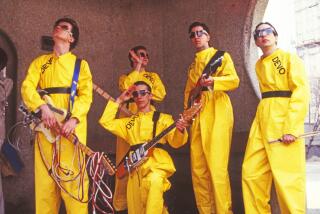Tackling Eno’s songs (by strategy)
- Share via
It was the mid-’70s. Before Brian Eno invented ambient music and produced seminal records by David Bowie and U2, the former Roxy Music keyboardist released a series of highly idiosyncratic albums that combined oblique pop melodies with dissonant sonics and stream-of-consciousness lyrics.
Even for the experimental ‘70s, albums such as 1974’s “Taking Tiger Mountain (By Strategy)” and 1977’s “Before and After Science” had a wildly eccentric feel to them. They created a jarring contrast of chaos and beauty, suggesting that Eno was seriously ahead of his time.
Thirty years later, re-created versions of songs from the “Tiger” album sounded fresh and mesmerizing as performed by the seven-piece Enorchestra on Wednesday at the Knitting Factory.
Created by San Francisco-based guitarist Doug Hilsinger and singer Caroleen Beatty, the project has been praised by Eno himself, and it’s easy to understand why.
If there is a fault with the original “Tiger” LP, it is the dryness of its robotic beats and flat vocalizing.
The Enorchestra’s massive live sound (three guitars, bass, two percussionists and raucous vocal harmonies) added a zesty immediacy to quirky nuggets such as “Mother Whale Eyeless” and the gloriously hypnotic “The Great Pretender.”
Purists may argue with Hilsinger’s decision to have a female vocalist tackling these songs, but Eno’s material was always strangely androgynous. Beatty’s full-bodied pipes brought a welcome touch of cabaret-style drama to the procedures.
The band had no problem reproducing the intricacies of the material at hand -- no small feat, considering that the original recordings boasted skillful players such as Phil Manzanera, Robert Wyatt and Phil Collins.
Functioning as much more than mere covers, the Enorchestra’s reinterpretations underscored Eno’s role as a British art-rock pioneer.
More to Read
The biggest entertainment stories
Get our big stories about Hollywood, film, television, music, arts, culture and more right in your inbox as soon as they publish.
You may occasionally receive promotional content from the Los Angeles Times.










